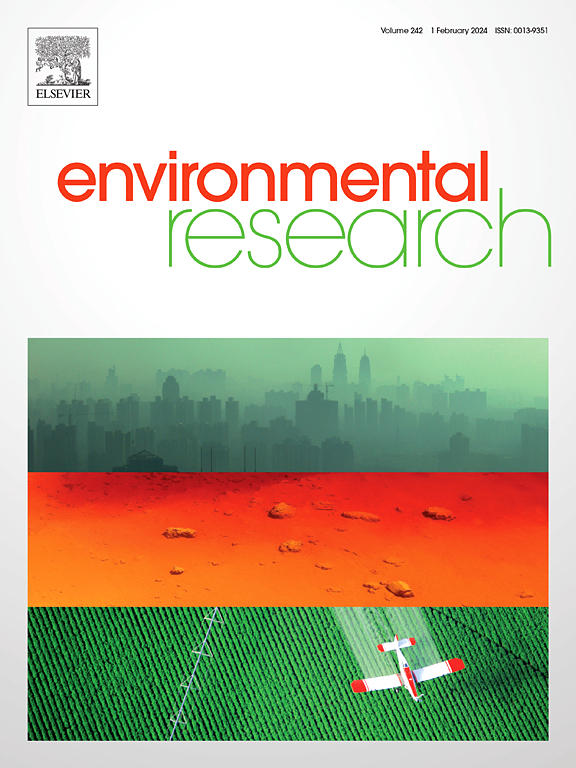The nonlinear association between temperature anomaly and serum lipid profiles: A nationwide longitudinal panel study
IF 7.7
2区 环境科学与生态学
Q1 ENVIRONMENTAL SCIENCES
引用次数: 0
Abstract
Background
Temperature anomaly (TA) caused by global climate change has been a risk factor for various health outcomes, but few studies reported its effects on serum lipid profiles. Therefore, we conducted a large population-based longitudinal panel study to investigate the association between TA and serum lipid profiles.
Methods
Individuals with at least two lipid tests and completing questionnaire surveys were included. Monthly TA were calculated based on an assimilated dataset of in situ observations, satellite remote sensing measurements and weather research forecast simulations. The TA values were categorized as three types: TA > 0 (sudden warming), TA < 0 (sudden cooling) and TA = 0 (no significant change). A fixed effect model was used to quantify the associations between lipid profiles and TA.
Results
A total of 295,233 individuals (689,621 visits) were included. Each increment in TA was significantly associated with increased risk of hyperbetalipoproteinemia [relative risk (RR) = 1.048, 95 % confidence interval (CI): 1.028–1.069], hypoalphalipoproteinemia (RR = 1.191, 95 %CI: 1.138–1.247), and hypercholesterolemia (RR = 1.056, 95 %CI: 1.033–1.080). Their corresponding attributable fractions were 4.62 % (95 %CI: 2.72 %–6.48 %), 16.06 % (95 %CI: 12.12 %–19.82 %) and 5.30 % (95 %CI: 3.19 %–7.37 %). The exposure-response relationships between TA and the risk of four types of dyslipidemia were estimated as J-shaped nonlinear curves centered at the TA value of zero. Sudden warming appeared to have a more pronounced effect on the risk of hyperbetalipoproteinemia, hypoalphalipoproteinemia and hypercholesterolemia than sudden cooling, whereas the opposite trend is observed for hypertriglyceridemia. All these associations were modified by climate zones and individual characteristics.
Conclusion
Temperature anomaly associated with increased risk of dyslipidemia, with varying associations across different climate zones and population subgroups. These results provide insights for the development of policies aiming at the prevention of dyslipidemia.
温度异常和血脂之间的非线性关系:一项全国性的纵向面板研究。
背景:全球气候变化引起的温度异常(TA)已成为多种健康结果的危险因素,但很少有研究报道其对血脂的影响。因此,我们进行了一项大规模的基于人群的纵向面板研究,以调查TA和血脂谱之间的关系。方法:纳入至少进行两次血脂测试并完成问卷调查的个体。每月TA的计算基于同化的现场观测数据集、卫星遥感测量数据集和天气研究预报模拟数据集。TA值分为3种类型:TA > 0(突然变暖)、TA < 0(突然变冷)和TA = 0(无显著变化)。一个固定效应模型被用来量化脂质谱和TA之间的关系。结果:共纳入295233人(689621次就诊)。TA的每增加都与高脂蛋白血症(相对危险度(RR) = 1.048, 95%可信区间(CI): 1.028-1.069)、低脂蛋白血症(RR=1.191, 95%CI: 1.138-1.247)和高胆固醇血症(RR=1.056, 95%CI: 1.033-1.080)的风险增加显著相关。其对应的归因分数分别为4.62% (95%CI: 2.72% ~ 6.48%)、16.06% (95%CI: 12.12% ~ 19.82%)和5.30% (95%CI: 3.19% ~ 7.37%)。估计TA与四种血脂异常风险的暴露-反应关系为以TA值为0为中心的j型非线性曲线。突然升温似乎比突然降温对高血脂血症、低血脂血症和高胆固醇血症的风险有更明显的影响,而对高甘油三酯血症的影响则相反。所有这些关联都受到气候带和个体特征的影响。结论:温度异常与血脂异常风险增加相关,在不同气候带和人群亚群中存在不同的相关性。这些结果为制定旨在预防血脂异常的政策提供了见解。
本文章由计算机程序翻译,如有差异,请以英文原文为准。
求助全文
约1分钟内获得全文
求助全文
来源期刊

Environmental Research
环境科学-公共卫生、环境卫生与职业卫生
CiteScore
12.60
自引率
8.40%
发文量
2480
审稿时长
4.7 months
期刊介绍:
The Environmental Research journal presents a broad range of interdisciplinary research, focused on addressing worldwide environmental concerns and featuring innovative findings. Our publication strives to explore relevant anthropogenic issues across various environmental sectors, showcasing practical applications in real-life settings.
 求助内容:
求助内容: 应助结果提醒方式:
应助结果提醒方式:


